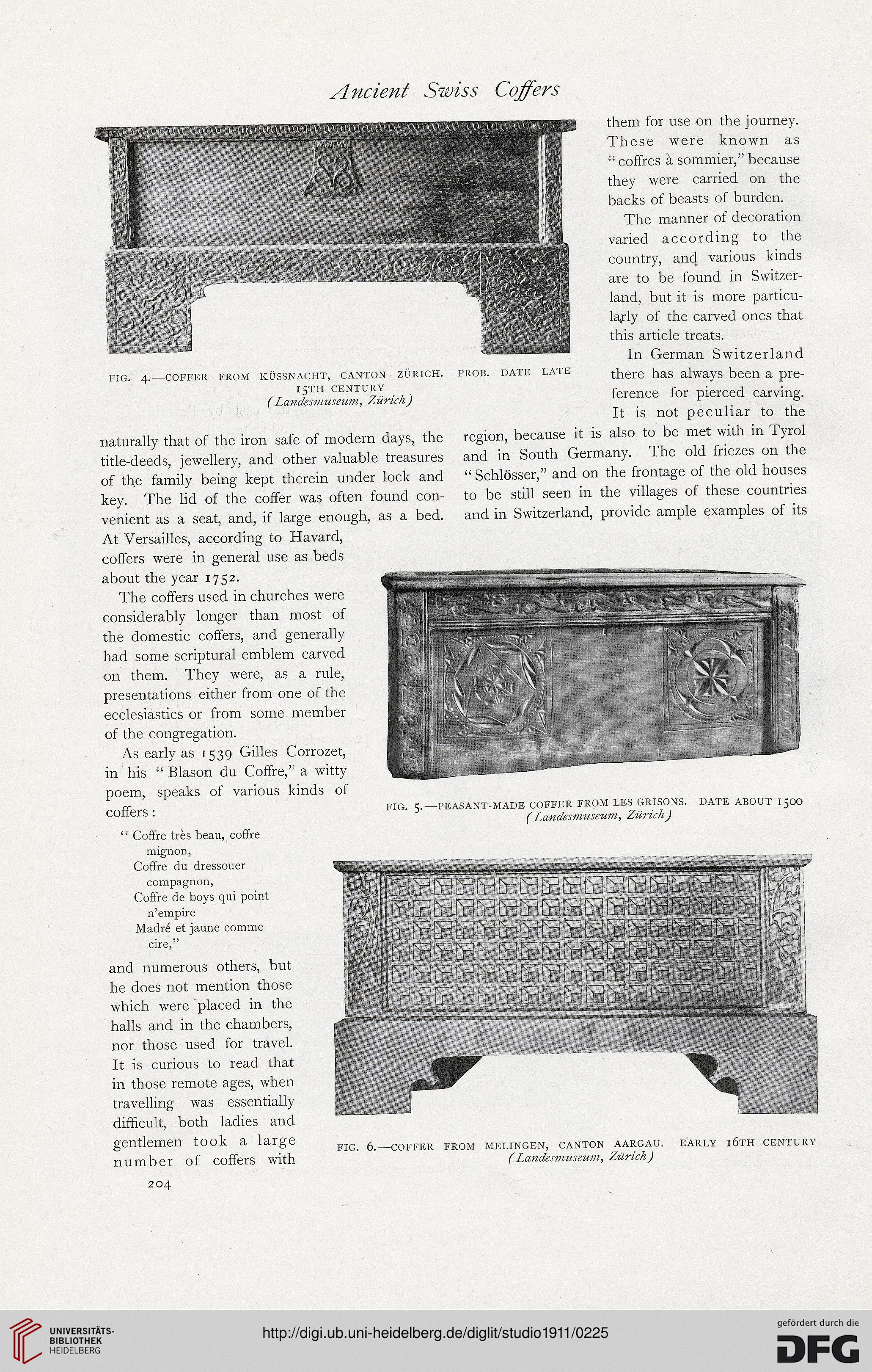A ncient Swiss Coffers
FIG. 4.—COFFER FROM KUSSNACHT, CANTON ZURICH.
I5TH CENTURY
(Landesmuseum, Zurich)
naturally that of the iron safe of modern days, the
title-deeds, jewellery, and other valuable treasures
of the family being kept therein under lock and
key. The lid of the coffer was often found con-
venient as a seat, and, if large enough, as a bed.
At Versailles, according to Havard,
coffers were in general use as beds
about the year 1752.
The coffers used in churches were
considerably longer than most of
the domestic coffers, and generally
had some scriptural emblem carved
on them. They were, as a rule,
presentations either from one of the
ecclesiastics or from some member
of the congregation.
As early as 1539 Gilles Corrozet,
in his “ Blason du Coffre,” a witty
poem, speaks of various kinds of
coffers :
them for use on the journey.
These were known as
“ coffres h sommier,” because
they were carried on the
backs of beasts of burden.
The manner of decoration
varied according to the
country, and various kinds
are to be found in Switzer-
land, but it is more particu-
larly of the carved ones that
this article treats.
In German Switzerland
there has always been a pre-
ference for pierced carving.
It is not peculiar to the
region, because it is also to be met with in Tyrol
and in South Germany. The old friezes on the
“ Schlosser,” and on the frontage of the old houses
to be still seen in the villages of these countries
and in Switzerland, provide ample examples of its
date about 1500
FIG. 5.—PEASANT-MADE COFFER FROM LES GRISONS.
(Landesmuseum, Zurich)
“ Coffre tres beau, coffre
mignon,
Coffre du dressouer
compagnon,
Coffre de boys qui point
n5 empire
Madre et jaune comme
cire,”
and numerous others, but
he does not mention those
which were placed in the
halls and in the chambers,
nor those used for travel.
It is curious to read that
in those remote ages, when
travelling was essentially
difficult, both ladies and
gentlemen took a large
number of coffers with
FIG. 6.—COFFER FROM MELINGEN, CANTON AARGAU. EARLY l6TH CENTURY
(Landesmuseum, Zurich)
204
FIG. 4.—COFFER FROM KUSSNACHT, CANTON ZURICH.
I5TH CENTURY
(Landesmuseum, Zurich)
naturally that of the iron safe of modern days, the
title-deeds, jewellery, and other valuable treasures
of the family being kept therein under lock and
key. The lid of the coffer was often found con-
venient as a seat, and, if large enough, as a bed.
At Versailles, according to Havard,
coffers were in general use as beds
about the year 1752.
The coffers used in churches were
considerably longer than most of
the domestic coffers, and generally
had some scriptural emblem carved
on them. They were, as a rule,
presentations either from one of the
ecclesiastics or from some member
of the congregation.
As early as 1539 Gilles Corrozet,
in his “ Blason du Coffre,” a witty
poem, speaks of various kinds of
coffers :
them for use on the journey.
These were known as
“ coffres h sommier,” because
they were carried on the
backs of beasts of burden.
The manner of decoration
varied according to the
country, and various kinds
are to be found in Switzer-
land, but it is more particu-
larly of the carved ones that
this article treats.
In German Switzerland
there has always been a pre-
ference for pierced carving.
It is not peculiar to the
region, because it is also to be met with in Tyrol
and in South Germany. The old friezes on the
“ Schlosser,” and on the frontage of the old houses
to be still seen in the villages of these countries
and in Switzerland, provide ample examples of its
date about 1500
FIG. 5.—PEASANT-MADE COFFER FROM LES GRISONS.
(Landesmuseum, Zurich)
“ Coffre tres beau, coffre
mignon,
Coffre du dressouer
compagnon,
Coffre de boys qui point
n5 empire
Madre et jaune comme
cire,”
and numerous others, but
he does not mention those
which were placed in the
halls and in the chambers,
nor those used for travel.
It is curious to read that
in those remote ages, when
travelling was essentially
difficult, both ladies and
gentlemen took a large
number of coffers with
FIG. 6.—COFFER FROM MELINGEN, CANTON AARGAU. EARLY l6TH CENTURY
(Landesmuseum, Zurich)
204




